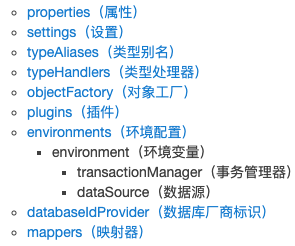前言
MyBatis主要用于持久层,就是负责和数据库进行直接交互的部分,主要学习的核心内容就是sql语句的拼接。约定大于配置。 复习Mybatis自己做记录。
一、配置文件法
1.mybatis.xml文件
配置信息的顺序必须严格遵循下图

①属性配置——properties
内部先加载,外部的后来居上,覆盖前者。
<properties resource="db.properties">
<propertie name="jdbc.name" value="name"/>
</properties>
②设置配置——settings
<settings>
<!--一级缓存(默认开启)-->
<setting name="cacheEnabled" value="true">
<!--日志配置-->
<setting name="logImpl" value="LOG4J"/>
</settings>
③别名配置——typeAliases
别名在配置文件中用,配置好后不用写全限定类名。
- 扫描一个类
<typeAliases>
<typeAlias aliase="User" type="com.xxx.pojo.User">
</typeAliases>
- 扫描一个包:根据set方法获取类名,别名为小写
<typeAliases>
<typeAlias package="com.xxx.pojo">
</typeAliases>
④数据库配置——environments(ssm框架中交给Spring)
<environments default="development">
<environment id="development">
<transactionManager type="JDBC"/>
<dataSource type="POOLED">
<property name="driver" value="com.mysql.jdbc.Driver"/>
<property name="url" value="jdbc:mysql://localhost:3310/javaweb?useSSL=false&useUnicode=true&characterEncoding=UTF8"/>
<property name="username" value="${username}"/>
<property name="password" value="${password}"/>
</dataSource>
</environment>
</environments>
⑤映射器配置——mappers
- 映射mapper文件
<mappers>
<mapper resource="com/study/dao/UserMapper.xml"/>
</mappers>
- 映射全限定类名——Mapper接口和配置文件同包
<mappers>
<mapper class="com.dao.UserMapper">
</mappers>
- 映射一个包内——Mapper接口和配置文件同包
<mappers>
<package name="com.dao"/>
</mappers>
2.Mybatis工具类
Mybatis中有下面三个非常重要的概念:
- SqlSessionFactoryBuilder:创建SqlSessionFactory后释放(局部变量)
- SqlSessionFactory:运行期间一直存在(单例模式/静态单例)连接池
- SqlSession:收到http请求就打开一个Sqlsession,返回响应后就关闭(方法作用域)连接请求
public class MybatisUtils{
//提升作用域
private static SqlSessionFactory sqlSessionFactory;
static{
try{
//使用Mybatis获取SqlSessionFactory对象
String resource = "mybatis-config.xml";
InputStream inputStream = Resource.getResourceAsStream(resource);
sqlSessionFactory = new SqlSessionFactoryBuilder().build(inputStream);
}catch(IOException e){
e,printStackTrace();
}
}
public static SqlSession getSqlSqlSession(){
//true:自动提交事务 ~ sqlSession.commit()
return sqlSessionFactory.openSession(true);
}
}
3.xxxMapper.xml
<!--绑定Mapper接口-->
<mapper namespace="com.dao.xxxMapper">
<!--
id:方法名
patameterType:参数类
resultType:结果类
-->
<select id="getUserById" parameterType="int" resultType="User">
select * from user where id = #{id}
</select>
</mapper>
4.实现方法
@Test
public void userTest(){
SqlSession sqlSession = MybatisUtils.getSession();
//通过sqlSession的getMapper方法获取Dao类,用于调用方法
UserMapper mapper = sqlSession.getMapper(UserMapper.class);
User user = mapper.getUserById(1);
//关闭sqlSession
sqlSession.close();
}
二、注解法
1.别名
①实体类起别名——@Alias
@Alias("User")
public class User{...}
②属性起别名——@Param
int test(@Param("user_id") int id)
2.CRUD——xxxMapper接口文件
①查——@Select
@Select("select * from user where id = #{id}")
User getUser(@Param("id") int id)
②增——@Insert
@Insert("insert into user(id,name,pwd) values (#{id},#{name},#{pwd})")
int insertUser(User user)
③改——@Update
@Update("update user set name=#{name}" where id = #{id})
int updateUser(User user)
④删——@Delete
@Delete("delete from user where id = #{id}")
int deleteUser(int id)
三、参数和结果集
1.参数——parameterType
- 直接传参
- 对象传参
- 一个基本参数,可以省略
- 多个参数,用Map/注解
万能Map传参
//Mapper接口
int addUser(Map<String,Object> map);
//测试方法
Map<String,Object> map = new HashMap<String,Object>();
map.put("key","value");
mapper.addUser(map);
2.结果集映射——resultMap
<select id="getUser" resultMap="UserMap">
select * from user
</select>
<resultMap id="UserMap" type="User">
<result property="实体字段" column="数据库字段">
</resultMap>
四、动态SQL
1.SQL复用
打包
<sql id="xxx">
sql语句
</sql>
引用
<include refid="xxx"></include>
2.标签
- if标签
<select>
select * from user
<if test="id!=null">
and id=#{id}
</if>
</select>
- choose(when,otherwise)
<choose>
<when test="xx!=null">xxx</when>
<when test="xx!=null">xxx</when>
<otherwise>xxx</otherwise>
</choose>
- trim->where,set
trim:
| 属性 | 意义 |
|---|---|
| prefix | 前缀 |
| suffix | 后缀 |
| prefixOverrides | 前缀覆盖 |
| suffixOverrides | 后缀覆盖 |
where:智能去除where和and,or等前缀
<select>
select * from user
<where>
<if test="#{name}!=null">name=#{name}</if>
<if test="#{sex}!=null">and sex=#{sex}</if>
</where>
</select>
<trim prefix="where" prefixOverrids="and|or">
xxx
</trim>
set:智能去除set和逗号后缀
<trim prefix="set" suffixOverrides=",">
- foreach:遍历集合,拼接sql语句
<!--select * from user where 1=1 and (id=1 or id=2 or id=3)-->
<select paramType="map">
select * from user
<where>
<!--
collection:map传的集合
open:拼接的开头
close:拼接的结尾
seprator:中间的分割
-->
<foreach collection="ids" item=id open="(" close=")" seprator="or">
id=#{id}
</foreach>
</where>
</select>
五、复杂查询
1.多对一:关联——association
方法一:子查询
<select id="getStudent" resultMap="StudentTeacher">
select * from student
</select>
<resultMap id="StudentTeacher" resulType="Student">
<result property="id" column="id"/>
<result property="name" column="name"/>
<association property="teacher" column="tid" javaType="Teacher" select="getTeacher" />
</resultMap>
<select id="getTeacher" resultType="Teacher">
select * from teacher where id = #{id}
</select>
方法二:按照结果嵌套查询
<select id="getStudent" resultMap="StudentTeacher">
select s.sid,s.sname,t.tname
from student s,teacher t
where s.sid=t.tid
</select>
<resultMap id="StudentTeacher">
<result property="id" column="sid"/>
<result property="name" column="sname"/>
<association id="teacher" javaType="Teacher">
<result property="id" column="tid"/>
<result property="name" column="tname"/>
</association>
</resultMap>
2.一对多:集合——collection
两个方法同上
<!--
ofType:集合里对象的类
-->
<collection property=students javaType="ArrayList" ofType="Student" />
六、缓存
减少与数据库的交互,减小开销,提高效率
经常查询但是不怎么修改的数据
1.一级缓存(默认开启LRU)
sqlSession中有效
缓存失效:
- ①查询不同东西
- ②增删改,缓存会刷新
- ③查询不同Mapper.xml
- ④手动清理缓存 sqlSession,clearCache();
2.二级缓存(注解sql不会二级缓存)
会话提交/关闭时,一级缓存数据提交到二级缓存中。
- 全局
<cache/>
- 单独设置
<select userCache="true"></select>






















 298
298











 被折叠的 条评论
为什么被折叠?
被折叠的 条评论
为什么被折叠?








